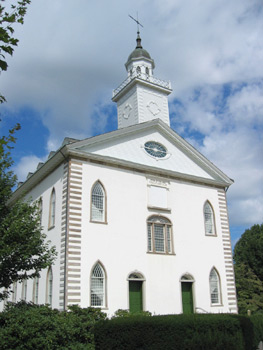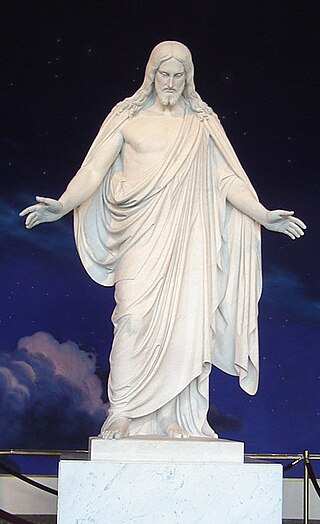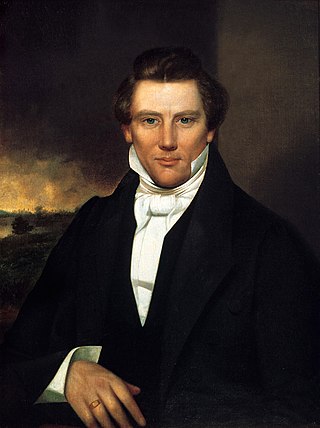
The Latter Day Saint movement is the collection of independent church groups that trace their origins to a Christian Restorationist movement founded by Joseph Smith in the late 1820s.

The Latter Day Saint movement is a religious movement within Christianity that arose during the Second Great Awakening in the early 19th century and that led to the set of doctrines, practices, and cultures called Mormonism, and to the existence of numerous Latter Day Saint churches. Its history is characterized by intense controversy and persecution in reaction to some of the movement's doctrines and practices and their relationship to mainstream Christianity. The purpose of this article is to give an overview of the different groups, beliefs, and denominations that began with the influence of Joseph Smith.

Adam-ondi-Ahman is a historic site in Daviess County, Missouri, about five miles south of Jameson. It is located along the east bluffs above the Grand River. According to the teachings of The Church of Jesus Christ of Latter-day Saints, it is the site where Adam and Eve lived after being expelled from the Garden of Eden. It teaches that the place will be a gathering spot for a meeting of the priesthood leadership, including prophets of all ages and other righteous people, prior to the Second Coming of Jesus Christ.

Far West was a settlement of the Latter Day Saint movement in Caldwell County, Missouri, United States, during the late 1830s. It is recognized as a historic site by the U.S. National Register of Historic Places, added to the register in 1970. It is owned and maintained by the Church of Jesus Christ of Latter-day Saints.

The Kirtland Temple is the first temple built by adherents of the Latter Day Saint movement and is located in Kirtland, Ohio, United States. Designed by Joseph Smith, the founder and original leader of the movement, the architecture mixes the Federal, Greek Revival, and Gothic Revival architectural styles. The temple is currently owned and operated by the Community of Christ, formerly the Reorganized Church of Jesus Christ of Latter Day Saints. It has been a National Historic Landmark since 1969.

In the Latter Day Saint movement, a temple is a building dedicated to be a house of God and is reserved for special forms of worship. A temple differs from a church meetinghouse, which is used for weekly worship services. Temples have been a significant part of the Latter Day Saint movement since early in its inception. Today, temples are operated by several Latter Day Saint denominations. The most prolific builder of temples of the Latter Day Saint movement is the Church of Jesus Christ of Latter-day Saints. The Church has 315 temples in various phases, which includes 178 dedicated temples, 58 currently under construction, and 79 others announced. Several others within the movement have built, or attempted to build, temples. The Community of Christ operates two temples in the United States, which are open to the public and are used for worship services, performances, and religious education. Other denominations with temples are the Apostolic United Brethren, the Church of Christ, the Fundamentalist Church of Jesus Christ of Latter-Day Saints and the Righteous Branch of the Church of Jesus Christ of Latter-day Saints.

Anti-Mormonism is discrimination, persecution, hostility or prejudice directed against the Latter Day Saint movement, particularly the Church of Jesus Christ of Latter-day Saints. The term is often used to describe people or literature that are critical of their adherents, institutions, or beliefs, or physical attacks against specific Mormons or the Latter Day Saint movement as a whole.

Florence Smith Jacobsen was an American religious leader associated with the Church of Jesus Christ of Latter-day Saints who served as the sixth General President of the Young Women's Mutual Improvement Association (YWMIA) from 1961 to 1972.

Since its organization in New York in 1830, The Church of Jesus Christ of Latter-day Saints has had a presence in Canada. The church's first missionaries to preach outside of the United States preached in Upper Canada; the first stake to be established outside of the U.S. was the Alberta Stake; and the Cardston Alberta Temple was the first church temple built outside of the boundaries of the United States.
Karl Ricks Anderson is a Latter-day Saint historian whose specialty is the Kirtland period in the history of the Latter Day Saint movement. He is a brother of Richard Lloyd Anderson and they were the second recipients of the Junius F. Wells Award from the Mormon Historic Sites Foundation in 2006.
Stanley Buchholz Kimball was a historian at Southern Illinois University. He was an expert on eastern European history and also wrote on Latter-day Saint history, including his ancestor Heber C. Kimball and the Mormon Trail.

Historic Kirtland Village, located in Kirtland, Lake County, Ohio, is the name given to a historic site. The village is owned and operated by the Church of Jesus Christ of Latter-day Saints.

The Church of Jesus Christ of Latter-day Saints in Ohio refers to the Church of Jesus Christ of Latter-day Saints and its members in Ohio. The official church membership as a percentage of general population was 0.52% in 2014. According to the 2014 Pew Forum on Religion & Public Life survey, roughly 1% of Ohioans self-identify themselves most closely with The Church of Jesus Christ of Latter-day Saints. The LDS Church is the 14th largest denomination in Ohio.

The John Whitmer Historical Association (JWHA) is an independent, nonprofit organization promoting study, research, and publishing about the history and culture of the Latter Day Saint movement. It is especially focused on the Community of Christ, other midwestern Restoration traditions, and early Mormonism. The Community of Christ's approach to its own history was influenced, in part, by historical problems raised and explored through JWHA publications and conferences, and those of its sister organization, the Mormon History Association. JWHA membership numbers around 400 and is open to all, fostering cooperation with LDS and non-Mormon scholars.

The following outline is provided as an overview of and a topical guide to the Church of Jesus Christ of Latter-day Saints.

The following outline is provided as an overview of and topical guide to the life and influence of Joseph Smith:
Wilford C. Wood, was an American businessman and prominent member of the Latter Day Saint movement who was responsible for acquiring many of the historic sites of the Church of Jesus Christ of Latter-day Saints, including the Nauvoo Temple site, Liberty Jail, and Adam-ondi-Ahman.

Lucy Smith Millikin was an American woman who was an early participant in the Latter Day Saint movement and a sister of Joseph Smith. She was the youngest child of Joseph Smith Sr. and Lucy Mack Smith. Millikin joined the Church of Christ when it was organized in 1830, and then moved to Kirtland, Ohio with her family in 1831, where she assisted in the effort to build the Kirtland Temple. After fleeing persecution in Far West, Missouri, she settled in Nauvoo, Illinois. When baptism for the dead was first introduced into the church, Millikin was one of the first Latter Day Saints to participate in the practice. She then joined the Relief Society and served a mission with her husband, Arthur Millikin, in Maine. Millikin chose not to follow Brigham Young and the Mormon pioneers west to Utah Territory, and was instead received into the Reorganized Church of Jesus Christ of Latter day Saints (RLDS) in 1873, though she never became very involved in the church. She died in Colchester, Illinois in 1882, at the age of 61.














